Saturday, November 25, 2006
online income
best ways to make money
business opportunities
can i make money
can i make money online
can you make money
do to make money
earn money
easiest way to make money
easy ways to make money
ecurrencies
ecurrency
everyday wealth
fastest way to make money
for teens to make money
get cash
get paid
get rich
get rich quick
get wealthy
getting paid
getting rich
home based businesses
home make money online
home based
homebased
homeworkers
homeworking
how can i make money
how do i make money
how do you make money
how make money
how much money can i make
how much money can you make
how to create a fortune
how to make big money
how to make easy money
how to make extra money
how to make fast money
how to make money
how to make money as a
how to make money at
how to make money at home
how to make money fast
how to make money for
how to make money from
how to make money from home
how to make money in real
how to make money in real estate
how to make money in stocks
how to make money in the
how to make money on
how to make money on the
how to make money on the internet
how to make money online
how to make money selling
how to make money using
how to make money with
how to make quick money
hyip
hyip's
hyips
i make money
i make money on
i make money online
i want to make money
ideas to make money
make a lot of money
make a money
make big money
make cash
make easy money
make easy money online
make extra money
make fast money
make good money
make money
make money and
make money as
make money at home
make money at home online
make money buying
make money doing
make money easily
make money easy
make money fast
make money fast on
make money fast online
make money for
make money from
make money from home
make money from online
make money from the
make money in
make money in real
make money in real estate
make money in stocks
make money in world
make money in world of
make money money
make money now
make money now at home
make money now at home online
make money off
make money off of
make money on
make money on line
make money on the
make money on the internet
make money on the web
make money online
make money online at
make money online by
make money online fast
make money online for
make money online forum
make money online from
make money online from home
make money online in
make money online no
make money online now
make money online survey
make money online surveys
make money online uk
make money online with
make money online work
make money out
make money over
make money over the
make money playing
make money quickly
make money surfing
make money surfing the
make money through
make money trading
make money uk
make money using
make money when
make money while
make money with
make money with a
make money with google
make money with online
make money with your
make money working
make money writing
make more money
make more money than
make online money
make real money online
make some money
make the money
make the most money
make too much money
making money
millionair
millionaire
millionaires
millionairs
millionare
millionares
money can you make
money do you make
money make
money make money
money to make
money you make
much money do you make
need to make money
online make money
people make money
quick cash
quick money
quick ways to make money
residual income
rich punk
that make money
the best way to make money
the internet treasure chest
the rich punk
to make a lot of money
to make a money
to make alot of money
to make big money
to make easy money
to make extra money
to make fast money
to make money
to make money as
to make money as a
to make money at
to make money at home
to make money by
to make money for
to make money for kids
to make money from home
to make money in
to make money in real estate
to make money in stocks
to make money in the
to make money on
to make money on the internet
to make money online
to make money quick
to make money quickly
to make money selling
to make money when
to make money with
to make money without
to make quick money
want to make money
way to make money
way to make money in
way to make money on
way to make money online
ways for kids to make money
ways to make extra money
ways to make money
ways to make money at
ways to make money fast
ways to make money for
ways to make money from
ways to make money in
ways to make money on
ways to make money online
we make money
work at home
work from home
workathome
workfromhome
working from home
Thursday, September 21, 2006
Hmmm....
From this seminar also i realize the importance to maintain healthy gingiva amongst this pregger as periodontal disease is related to premature low weight babies.I thought that this theory haven't been proven.Seems that after 5 months leaving uni,my fact kinda out of date already...hmm..guess i gotta keep my self up to date.I wanna attend the international paeds seminar that its going to be held somewhere in nov but i think i wont be able to attend it as i have to cover the clinic for 2 month.I'll be working without any supervision for 2 months..he..he..dunno whether its a blessing in disguise or what.
Wednesday, September 20, 2006
Part Time Job
I'm a big fan of manchester united and AC Milan!!!I love Kaka and Cristiano Ronaldo!!!
Friday, August 25, 2006
Caries..caries..and CARIES
Well...im kinda sad that in the place that im working the caries rate is very high...almost every patient have caries.And its big..but there's nothing i can do as the awareness here is verry low.i hope that in years from now..the scenario will change towards a better dental health in these people.
Saturday, May 20, 2006
Updates...
well..now i'm into american idol.i was very devastated that Eliot was eliminated from american idol. i really hate Taylor Hicks. I hope he won't be the next american idol. i hate everything about him.His hair...his look..his dancing.he's suck.
i'm also into the sims 2 now. i dunno how to install the sims 2 expansion pack, open for business.everytime i tried to install..there is this notice that say' the sim 2 is not properly install or not install in your computer'.why is that???help anybody???
Thursday, May 04, 2006
Bad Day
You kick up the leaves and the magic is lost
They tell me your blue skies fade to grey
They tell me your passion's gone away
And I don't need no carryin' on
You stand in the line just to hit a new low
You're faking a smile with the coffee you go
You tell me your life's been way off line
You're falling to pieces everytime
And I don't need no carryin' on
Cause you had a bad day
You're taking one down
You sing a sad song just to turn it around
You say you don't know
You tell me don't lie
You work at a smile and you go for a ride
You had a bad day The camera don't lie
You're coming back down and you really don't mind
You had a bad day You had a bad day
Well you need a blue sky holiday
The point is they laugh at what you say
And I don't need no carryin' on
You had a bad day
You're taking one down
You sing a sad song just to turn it around
You say you don't know
You tell me don't lie
You work at a smile and you go for a ride
You had a bad day The camera don't lie
You're coming back down and you really don't mind
You had a bad day
(Oh.. Holiday..)
Sometimes the system goes on the brink
And the whole thing turns out wrong
You might not make it back and you know
That you could be well oh that strong And I'm not wrong
So where is the passion when you need it the most
Oh you and I
You kick up the leaves and the magic is lost
Cause you had a bad day
You're taking one down
You sing a sad song just to turn it around
You say you don't know You tell me don't lie
You work at a smile and you go for a ride
You had a bad day You've seen what you like
And how does it feel for one more time
You had a bad day You had a bad day
Had a bad day Had a bad day
Saturday, March 18, 2006
Depressed.....
Friday, March 10, 2006
American idol
Thursday, March 02, 2006
Ouch...my wisdom tooth is painful...
Why do we have wisdom teeth?
Adults can have up to 32 teeth. The wisdom teeth are the last to come through, right at the back. They usually appear when you are between 17 and 25. Although sometimes they appear many years later. Nowadays people often have jaws that are too small for all 32 teeth – 28 is often the most we have room for. So if all the other teeth are present and healthy there may not be enough space for the wisdom teeth to come through properly.
Do wisdom teeth always cause problems?
No. If there is enough room they will usually come through into a useful position and cause no more problems than any other tooth. Often there will be some slight discomfort as they come through, but this is only temporary and will disappear once the tooth is fully in position.
What is an impacted wisdom tooth?
If there is not enough room, the wisdom tooth may try to come through, but will get stuck against the tooth in front of it. The wisdom tooth will be at an angle, and will be described by the dentist as ‘impacted’.
What problems should I be prepared for with wisdom teeth?
If part of the wisdom tooth has appeared through the gum and part of it is still covered, the gum may become sore and perhaps swollen. Food particles and bacteria can collect under the gum edge, and it will be difficult to clean the area effectively. Your dentist will tell you whether this is a temporary problem that can be dealt with by using mouthwashes and special cleaning methods (and possibly antibiotics), or whether it is better to have the tooth removed.
What can I do to help relieve the discomfort of wisdom teeth?
If your gums are sore and swollen, use a mouthwash of medium hot water with a teaspoonful of salt. (Check that it is not too hot before using it.) Swish the salt water around the tooth, trying to get into the areas your toothbrush cannot reach. An antibacterial mouthwash such as Corsodyl can also reduce the inflammation. Pain-relieving tablets such as paracetamol or aspirin can also be useful in the short term, but see your dentist if the pain continues.
But if it does not help?
If the pain does not go away or if you find it difficult to open your mouth, you should see a dentist. They will be able to see the cause of the problem, and tell you what to do. It may help to clean around the tooth very thoroughly, and the dentist may give you a prescription for an antibiotic.
Are x-rays needed for wisdom teeth?
The dentist will usually take x-rays to see the position of the root, and to see whether there is room for the tooth to come through into a useful position.
What are the main reasons for taking wisdom teeth out?
When it is clear that the wisdom teeth will not be able to come through into a useful position because there is not enough room, and they are also causing some pain or discomfort.
· If they have only partly come through and are decayed – such teeth will often be more likely to decay as it will be difficult to clean them as thoroughly as your other teeth.
· If the wisdom tooth is causing a cleaning problem and has no real use.
· If the wisdom tooth starts to ‘over-grow’. This often happens if the lower one has already been removed or is impacted and cannot come through, and the upper one has no tooth to bite against. The upper one will come down too far, looking for a tooth to make contact with.
· If they are painful.
Are wisdom teeth difficult to take out?
It all depends on the position and the shape of the roots. Your dentist will tell you how easy or difficult each tooth will be to remove after looking at the x-rays. Upper wisdom teeth are often easier to remove than lower ones, which are more likely to be impacted. Your dentist will say whether the tooth should be taken out at the dental practice, or whether you should be referred to a specialist (oral surgeon) at a hospital. Very occasionally there is a possibility of some numbness of the lip after the removal of a lower tooth – your dentist will tell you if it is possible in your case. You will probably have either a local anaesthetic – as you would have for a filling – or sedation. You could also have a general anaesthetic (where you would be asleep), but this will usually be given only in a hospital.
Will it make any difference to my face or mouth?
Taking wisdom teeth out may cause some swelling for a few days. But as soon as the area is healed, there will be no difference to your face or appearance. Your mouth will feel more comfortable and less crowded, especially if the teeth were impacted.
What should I expect after a wisdom tooth is taken out?
The amount of discomfort will depend on how easy it was to take the tooth out. There is usually some swelling and discomfort for a few days afterwards, and it is important to follow any advice you get about mouthwashes and so on, to help with the healing. Some people also find homeopathic remedies help to reduce discomfort.
Usual pain-killers such as paracetamol, aspirin or ibuprofen will usually deal with any pain. It is best to stay fairly quiet and relaxed for 24 hours afterwards to make sue there are no bleeding problems. There may be some stitches to help the gum heal over. Your dentist will probably want to see you again about a week later to check on the healing, and to remove any stitches.
Sunday, February 12, 2006
Dental Caries a.k.a tooth decay
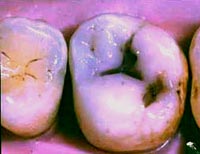
Define as...
The progressive loss of tooth mineral, followed by bacterial invasion into the demineralized tooth.
Usually occur in....
1.pit and fissue: develop initially in the fissures of the teeth, but can spread into the dentine, causing complete breakdown of the tooth
2. smooth surface: most common on the interdental surfaces, but can occur on any smooth surface of the tooth; enamel is gradually broken down and an open cavity is formed
3. cemental: involves the cementum of a tooth
What is...
1. recurent: caries that arise around an exisiting retoration due to an alteration in the integrity of the resotration
2.acute (rampant): dental caries that involve several teeth, appear suddenly, and often progress rapidly
3. chronic: dental caries progressing slowly over time in several teeth
4. enamel caries: caries that involves the enamel of a tooth
5. dentin caries: caries that spreads along the dentinoenamel junction and involves dentinal tubules, eventually reaching the pulp
Clinical Features:
any gender or age
toothache; sensitivity to hot or cold food or drinks
chalky white deposit in enamel surface of tooth, visible pits, or holes in the teeth
brown yellowish cavitation of the teeth
surface of the tooth may be soft
Radiographic Features:
may show some cavities early
Etiology:
multifaceted: saliva, microflora, diet
Tissue of Origin:
enamel, dentin
Main Pathologic Process:
inflammation
Treatment:
1.changing the microflora, using agents such as topical chlorhexidine and topical fluoride
2.reducing the amount of dietary sucrose
3.decreasing the frequency of eating
4.adding fluoride, particularly through daily tooth brushing
5.increasing salivary flow, using mechanical stimulation during vigorous chewing or by using drugs
Prognosis:
good when diagnostic tests show that the disease is no longer active and the risk is low
untreated the dental decay my lead to a dental abscess
Monday, February 06, 2006
Resume= Headache

I haven't updated this blog for quite some times as i was very...very...busy.
Well...i have to write a resume as i'm going to apply post as dental officer soon im my place. My interview is on valentine's day..so if u r reading this wish me luck.
I have gather some tips for writing a resume..so help urself if u needed these tips. i'll be writing about dental stuff soon.
There's a whole publishing industry dedicated to writing resumes, on the Net and in print. Even a short surf will reveal many sites. Some of them say the same old thing.
For sure, there is only so much you can do with your resume at the end of the day. However, you can certainly make it look better than just ok. Creating an outstanding resume isn't difficult, but it does require some careful thought. It requires analysis of your strengths, some organization and definitely some creativity.
First things first, though. Below we highlight some key points to help you understand what goes into a resume and how it should look.
What's the difference between a resume and a CV?
There is no real difference, except the first is a French word used commonly today in companies that use American English. The CV is originally a Latin word, and is used more frequently in British companies.
Today however, internationalisation and globalisation have made the word resume the most commonly used term. Most companies tell us they don't particularly care what word you use. What's more important is the information it reveals about you.
It's not to get you the job
Remember this: the resume is not supposed to get you the job; it's only to get you the face-to-face interview. Experienced recruiters - when they see a resume for the first time - will scan it in less than one minute UNLESS something in it makes them want to read further.
So, here are some pointers that highlight skills (compiled from our own experience as well conversations with CEOs, MDs and HR Directors - to help make your resume stand out. Take note that these skills go beyond the academic qualification.
Highlight Key skills
Most employers look for evidence of leadership, teamwork, commitment, innovation and communication skills. They also want a positive attitude, and someone who shows they are willing to learn and not disdainful of doing menial tasks.
Not your life story, please!
A resume is a summary of your education and experience, not your entire life story. It is meant to highlight your potential as a valuable employee. Obviously, as a fresh graduate you may not have as much to say compared to an experienced person. But that doesn't mean you exaggerate your abilities.
Length does matter
Some companies prefer one-page resumes, and more conventional formats. Others look for resumes that look and sound different. It really depends on the company and the industry, so do your homework. In general, however, they all like it short and easy to scan. For a fresh graduate, keep it to a maximum of two pages.
Use action verbs
These are action words like initiated, implemented, planned, managed, organised, analysed, participated, performed, assisted and prepared. They are very effective. Avoid saying you were 'involved' in something as it is a vague word and suggests you did not play a significant role in the activity - and therefore did not learn much from the experience.
Get the language right
All the enthusiasm in the world won't help, if you letter is full of spelling mistakes and bad grammar. Unfortunately, an astonishing number of resume's received by the private sector today are full of them. If you are not confident about your English, get someone to help you. Even if at the interview, the interviewer notices your lack of fluency in English, he/she will be impressed that you took the effort to ensure your written resume was impeccable. It reveals that you are willing to ask for help and want to improve, two great attitudes to have!
Use numbers to your advantage
Numbers are powerful and here are some examples you can use:
*Recruited 20 volunteers to help in the Annual Inter-Varsity Ball
*Managed 5 committees to plan for the National Debate Competition
*Interviewed 10 companies to write a 3,000-word article on the impact of the SARS epidemic on tourism for the college magazine
*Presented the weekly 30-minute campus radio call-in show that has an audience of 1,000 students
Education
Your education is the first criteria of consideration for a potential employer, but it's not the only decisive factor. Your primary school does not need to be included. As a fresh graduate, you probably will need to list your secondary school information - keep it short though, highlighting any special prizes or achievements.
Listing of courses
There is no need to list every single course you have studied at university/college. Just highlight the ones relevant to the job you're applying for. Remember to include courses that are also not directly related to your major area of study, but show that you are multi-disciplinary skills. For example, if you have a degree in engineering, it would be good to show that you have taken subjects in Finance, Marketing, or Mass Communications.
Listing extra-curricular activities
Extra-curricular activities are an important reflection of how well-rounded a person you are. This shows that you have interests beyond just studying. Extra-curricular activities are excellent to show teamwork, leadership, competitiveness and communication skills - which are valued by employers. Extra-curricular activities would include any activity outside of university/college hours. ('Lepak', however, is not such an activity!").
Highlighting achievements
If you won 1st place in a Talent Competition, or were Captain of the Football Team, these should definitely go on your resume under the heading Achievements. Even if you weren't in a leadership position, but were on a winning team, that's important information. Also, if you didn't win a talent competition, your participation shows initiative and courage and a fun personality. Do not underestimate the value a prospective employer sees in such activities.
Special skills
These would include additional skills you have such as being able to speak more than one language, fluency in sign language, or any other specific technical skills.
Look Alive!
It is common practice in Malaysia for employers to ask job applicants to send photographs. This is not necessarily the practice in other countries. If asked for a photograph, it means the way you look is an important criteria for employment. Get a good photograph taken - not one that makes you look like a suspect in a police line-up!
Many photographs we see show people who look bored, listless or half-dead! Make the effort to look alive and intelligent! And don't forget to Smile!
Personal information
In Malaysia, it is common for prospective employers to ask for personal information like your weight, height, race, religion and marital status. This, however, is slowly going out of style. Also, just because most people include it in their resume's, it doesn't mean you have to. This is something you have to decide for yourself.
Salary
Many job vacancy postings give you no idea of the salary; instead it asks the applicant to state the expected salary. The best thing is to ask around. Do some research and find out what companies are generally offering fresh graduates.
References
Always include references. Don't say Available Upon Request. If you want the job, then make every effort to ensure your resume is as complete as possible. Provide copies of important certificates, references, recommendations and samples of your work. For references, always include their full name, title and contact telephone numbers. Also, make sure you have their permission to use them as a referee.
Saturday, January 21, 2006
Missing Tooth@teeth???What should i do???
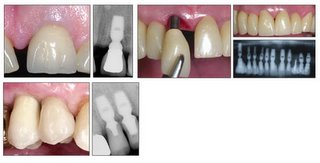
Figure above showed a case of dental implant.
What are dental implants?
An alternative to dentures, dental implants (small dental appliances that are inserted into the upper and lower jaws) help to restore the mouth that has little or no non-restorable teeth. Dental implants are slowly replacing dentures used by some people, as they provide many advantages of traditional dentures.
Advantages of implants over dentures:
1.reduce movement of dentures, bridges, and/or crowns
2.facilitate proper chewing
3.provide support and improved stability for removable dentures or fixed bridge work
4.approximate the "feel" of natural teeth better than dentures
5.promote "denture self-confidence", as speech and appearance are often improved
1.the patient must be healthy
2.healing abilities affected by a disease may affect the successfulness of an implant
3.a proper diagnosis must be made before an implant can be placed
4.placement and technique is specific to each individual candidate
5.to further prevent complications, the implant(s) must be treated properly by the patient and the dentist
6.heavy smoking and drinking may affect the successfulness of an implant
1. an artificial bone substitute
2. endosteal implants
3. subperiosteal implants
Dental implants may either be inserted by a dentist specially training in implantology, or by an oral surgeon in a hospital.
Thursday, January 19, 2006
Fluoride & Caries
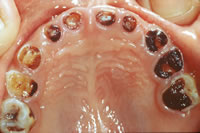 Figure: Severe carious teeth
Figure: Severe carious teethOnline Degree Anyone??
Ok..so, what are the benefit of an online study???
1. Convenience - It is possible to study entire courses all from the convenience of your own home, public libraries or workplace. Online course information, tutors and fellow students can be accessed at any time using e-mail or FirstClass. Assessment can be submitted at any time.
2. Up to date Information - The Internet is very quick to update. So you can be sure information in your Online Course Study Guides is the latest, most relevant information
3. Flexibility - The study sites have been designed to be easily navigated. You are able to study Online in the order you choose.
4.Totally self-paced - Some Online degree courses are designed to be entirely self paced. The amount of information learnt, when assessment is taken, how much you network with other students, all these components can be arranged for your individual needs, and around your current commitments. The self-paced Online degree nature is very important for mature aged students, who have many commitments that can change from week to week. Easy, fast and cheap communication with your teachers, class supervisors and fellow students via e-mail, TAFEVC or FirstClass.
5. Convenient communication - You don’t have to organise communication around the availability of your teacher being on-site at the Institute. Online Degrees are convenient.
so...what are the differences between distant learning and online study???
Both distance and online education provide you flexibility for where and when you study. However, studying online is totally interactive with immediate correction of the exercises.Studying online offers you additional opportunities for interaction through email, discussion boards and chat rooms, enabling you to communicate with your personal tutor and thereby enchancing the learning experience.
Using Online Degrees Today, you can prepare for a successful career in the online subject of your choice. Whether you are interested in online degrees in the areas of Business, Accounting, Technology, Nursing, Criminal Justice, Web Design and more, there is a online degree education program available. Online Degrees available for Associates, Bachelors, Masters & Certificate programs in most fields.
well..i guess that should cover the basic.For more information, please visit www.online-degrees-today.com
Tuesday, January 17, 2006
Pregnancy & Oral health
Apart from other bodily changes directly related to pregnancy, 60 to 75% of pregnant women will experience increased gingivitis, beginning in the second or third month of pregnancy, which increases in severity through the eight months and begins to decrease in the ninth month. This condition known as pregnancy gingivitis is characterized by swelling, bleeding and redness in the gum in response to only small amounts of plaque or calculus. In addition the pyogenic granuloma ( pregnancy epulis or pregnancy tumour ) of pregnancy is well recognised. There are growths at the gum margins which sometimes enlarge to substantial size and bleeds easily on trauma necessitating surgical removal.
Morning sickness, food cravings and general malaise during the first Trimester can result in poor oral health resulting in fresh caries in certain susceptible teeth. Pregnancy - related oral care problems can be prevented or controlled by good oral hygiene habits. Notify your dentist when you find out that you are pregnant because the dentist may schedule more frequent cleanings, reinforce brushing and flossing habits or recommend products like oral irrigation or mouth rinses that will help ensure you are getting a good cleaning at home.
It is advisable to reschedule any elective medical or dental treatment during the first trimester of pregnancy where the body systems and organs of the foetus is starting to form. To protect you and the foetus from unnecessary drugs or x-rays, your dentist can schedule elective procedures during the second trimester where the foetus is less vulnerable ( and you are likely to be more comfortable ) than in the late stages of pregnancy. Should there be a history of miscarriage it may be advisable to delay treatment ( within reason ) until after you deliver. If there's an emergency, dental X-rays are permissible because of the low doses of radiation used. Wearing a lead apron will further insulate the baby from exposure. Request your dentist to use ass little local anaesthetic as possible to limit the foetus exposure to chemical and to substitute safer alternative drugs known to be detrimental to the developing foetus. Studies have shown that a mother-to-be's nutrition is important to the baby's oral and facial development. A pregnant women's diet should include sufficient amounts of nutrients especially Vitamin A, C and D with Calcium, Phosphorus and the recommended amount of protein. This is taken over and above a normal balanced diet with plenty of fruits, vegetables and fibre. A recent study indicated that gum infections in a pregnant woman may lead to a seven fold increase in the risk of delivering a premature low birth weight baby. There is a suggestion that untreated periodontal disease may account for a large number of unexplained premature deliveries.
Most patient with neglected mouths including some pregnant women blame their poor oral condition with the following common excuses.
a)
I don't have time for the whole brush-and-floss routine.
b)
My mouth hurts when I brush.
c)
I am too embarrassed to brush in publish rest room after lunch. Flossing hurts and is too awkward for me.
d)
The taste of toothpaste turns my stomach.
e)
I don't feel well and I have jaw pain that prevents me from opening wide enough to floss and brush my back teeth.
Please see your dentist who will resolve all these issues in no time at all
Sunday, January 15, 2006
Yucks...I have yellowish teeth!!!
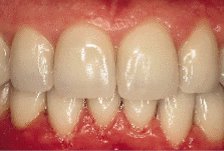
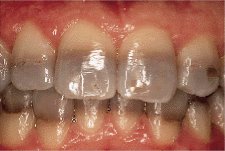
Fig 1: severe tooth discolouration Fig 2: after veneer placement
Why do my teeth have stains and discolorations?
Most stains are caused by age, tobacco, coffee, or tea. Other types of stains can be caused by antibiotics, such as tetracycline; or too much fluoride.
What treatments are used for stained teeth?
Ask your oral health care professional about tooth-whitening options. They include a number of over-the-counter whitening systems, whitening toothpastes, and the latest high-tech option--laser tooth whitening. For maximum whitening, experts agree that peroxide is usually the way to go.
Supervised bleaching procedures that are done in-office and at-home have become among the most popular treatment options. In some cases, the procedure is performed entirely in the office, using a light or heat source to speed up the bleaching process. In other cases, an oral health care professional gets the procedure started during an office visit and then gives you what you need to complete it at home. Still another popular procedure is one that you complete entirely at home.
At-home procedures, sometimes called nightguard vital bleaching, consist of placing a bleaching solution, usually a peroxide mixture, in a tray (nightguard) that has been custom fitted for your mouth by an oral health care professional. The bleaching solutions may vary in potency and may be worn for an hour, or throughout the night. Your oral health care professional can advise you on the appropriate type of application and the length of time needed to whiten your teeth, based on the severity of tooth discoloration and your specific needs.
How effective are bleaching systems?
Bleaching is effective in lightning most stains caused by age, tobacco, coffee, and tea. Based on clinical studies, 96 percent of patients with these kinds of stains experience some lightening effect. Other types of stains, such as those produced by tetracycline use or fluorosis (too much fluoride), respond to bleaching less reliably. And one cosmetic dentist points out that bleaching systems are not fully predictable. If you have a tooth-color filling when your teeth are bleached, the filling will stay yellow dental restorations do not change color when tooth whitener is applied.
Are there any side effects to tooth bleaching?
In some studies, patients have experienced uncomfortable short-term side effects when having teeth bleached. Hydrogen peroxide can increase temperature sensitivity in the teeth, particularly at higher concentrations, and nightguards often cause gum irritation. And overzealous use of over-the-counter home bleaching products can wear away tooth enamel, especially with solutions that contain acid. Therefore, bleaching is a procedure best done under the care of an oral health care professional. Still, the general health risks of bleaching systems are minimal as far as your body is concerned. Applications are controlled so that you don't swallow hydrogen peroxide.
What's Available?
While research continues into all types of bleaching systems, tooth bleaching is sure to continue to grow in popularity. Here's a selection of what's currently available.
1. At-home bleaching kitshe most popular whitening option. Mouth trays are usually made in one office visit, and your oral health care professional will provide a whitening brand suitable to your needs. Some trays are worn for an hour, others through the night. Kits range from price from $300 to $500.
2. Bonding composite resin that is molded onto the teeth to change their color and to reshape them. The resin material can stain and chip over time. Bonding can usually be done in one office visit for $300-$700 per tooth.
3. Porcelain veneers?these shell-like facings can be bonded onto stained teeth. They are used to reshape and/or lengthen teeth as well as to whiten. Veneers require at least two office visits and cost $700 to $1,200 per tooth.
4. Whitening Toothpastes?While some whitening toothpastes effectively keep the teeth cleaner and, therefore, looking whiter, some are more abrasive than others. The stronger toothpastes rely on abrasion to remove external stains as opposed to actually changing the color of teeth. The key is to study a product's ingredients, look at your teeth to see if it changes their color, and consult your oral health care professional for customized advice.
Saturday, January 14, 2006
Thursday, January 12, 2006
Cancer in the mouth???Is it possible???

Mouth cancer can affect the lips, tongue, cheeks and throat. There are 4,400 new cases and 1,700 deaths every year in the UK, and those figures are increasing each year. Survival chances are much improved with early detection, so the number of deaths could be greatly reduced if people were more aware of the symptoms. The first sign of mouth cancer is often a non-healing mouth ulcer or a red or white patch in the mouth. It is important that you examine your own mouth on a regular basis. If you have a mouth ulcer that hasn’t healed after three weeks, or you notice any unusual changes in your mouth you should visit your dentist as soon as possible for an examination. Mouth cancer is most common in people over 40 who smoke or drink alcohol. It is also twice as likely to strike men as women. However, the number of young people and women developing the condition has been increasing in recent years. You can cut your risk of developing mouth cancer by living a healthy lifestyle.If mouth cancer is diagnosed in its early stages it can respond well to treatment and the chances of a complete cure are good. This is why regular dental check-ups are so important.
FAQ about Mouth Cancer
What is mouth cancer?
Most people have heard of cancer affecting parts of the body such as the lungs or breasts. However, cancer can occur in the mouth, where the disease can affect the lips, tongue, cheeks and throat.
Who can be affected by mouth cancer?
Anyone can be affected by mouth cancer, whether they have their own teeth or not. Mouth cancers are more common in people over 40, particularly men. However, research has shown that mouth cancer is becoming more common in younger patients and in women. There are, on average, over 4,300 new cases of mouth cancer diagnosed in the UK each year. The number of new cases of mouth cancer is on the increase.
Do people die from mouth cancer?
Yes. Nearly 1,700 people in the UK die from mouth cancer every year. Many of these deaths could be prevented if the cancer was caught early enough. As it is, people with mouth cancer are more likely to die than those having cervical cancer or melanoma skin cancer.
What can cause mouth cancer?
Most cases of mouth cancer are linked to tobacco and alcohol. Cigarette, cigar and pipe smoking are the main forms of tobacco use in the UK. However, the traditional ethnic habits of chewing tobacco, betel quid, gutkha and paan are particularly dangerous. Alcohol increases the risk of mouth cancer, and if tobacco and alcohol are consumed together the risk is even greater. Over-exposure to sunlight can also increase the risk of cancer of the lips.
What are the signs of mouth cancer?
Mouth cancer can appear in different forms and can affect all parts of the mouth, tongue and lips. Mouth cancer can appear as a painless mouth ulcer that does not heal normally. A white or red patch in the mouth can also develop into a cancer. It is important to visit your dentist if these areas do not heal within two weeks.
How can mouth cancer be detected early?
Mouth cancer can often be spotted in its early stages by your dentist during a thorough mouth examination. If mouth cancer is recognised early, then the chances of a cure are good. Many people with mouth cancer go to their dentist or doctor too late.
What is involved in a full check-up of the mouth?
The dentist examines the inside of your mouth and your tongue with the help of a small mirror. Remember, your dentist is able to see parts of your mouth that you cannot see easily yourself.
What happens if my dentist finds a problem?
If your dentist finds something unusual or abnormal they will refer you to a consultant at the local hospital, who will carry out a thorough examination of your mouth and throat. A small sample of the cells may be gathered from the area (a biopsy), and these cells will be examined under the microscope to see what is wrong.
What happens next?
If the cells are cancerous, more tests will be carried out. These may include overall health checks, blood tests, x-rays or scans. These tests will decide what course of treatment is needed.
Can mouth cancer be treated?
If mouth cancer is spotted early, the chances of a complete cure are good, and the smaller the area or ulcer the better the chance of a cure. However, too many people come forward too late, because they do not visit their dentist for regular examinations.
How can I make sure that my mouth stays healthy?
• It is important to visit your dentist at least once a year, even if you wear dentures. This is especially important if you smoke and drink alcohol.• When brushing your teeth, look out for any changes in your mouth, and report any red or white patches, or ulcers, that have not cleared up within two weeks.• When exposed to the sun, be sure to use a good protective sun cream, and put the correct type of barrier cream on your lips. • A good diet, rich in vitamins A, C and E, provides protection against the development of mouth cancer. Plenty of fruit and vegetables help the body to protect itself, in general, from most cancers. • Cut down on your smoking and drinking. Regular visits to your dentist could save your life.
Monday, January 09, 2006
Ouch.....
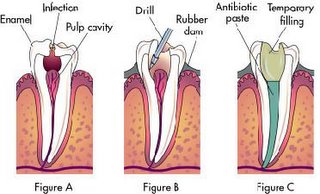
Once upon a time, if you had a tooth with a diseased nerve, you'd probably lose that tooth. Today, with a special dental procedure called a root canal therapy you may save that tooth. Inside each tooth is the pulp which provides nutrients and nerves to the tooth, it runs like a thread down through the root. When the pulp is diseased or injured, the pulp tissue dies. If you don't remove it, your tooth gets infected and you could lose it. After the dentist removes the pulp, the root canal is cleaned and sealed off to protect it. Then your dentist places a crown over the tooth to help make it stronger.
Most of the time, a root canal is a relatively simple procedure with little or no discomfort involving one to three visits. Best of all, it can save your tooth and your smile!
Figure A is when infection reaches the root canal system.Figure B is the procedure which the dentist drill the tooth to drain the pus and Figure C is the filling for the tooth after completion of RCT.
The procedure
Here is what you can expect when you schedule a root canal treatment.
On the initial visit:Local anesthetic usually is given, to maintainpatient comfort
The affected tooth is isolated from saliva with arubberlike sheet called a dam.An opening is made through the crown of thetooth. The pulp is removed, and then the root iscleaned and shaped. Medication may be added tothe pulp chamber and root canal(s) to help eliminatebacteria.A temporary filling is placed in the crownopening to keepsaliva out. Antibioticsmay be prescribedif an infectionis present andhas spread beyondthe end of theroot(s).On the nextvisit:The temporaryfilling is removed.The root canalis filled and permanentlysealed.(A metal or plasticrod or post may beplaced in the rootcanal for structuralsupport.)If an endodontistperforms theprocedure, he orshe usually willsend you back to your general dentist for preparationof a crown to be placed on the tooth. Crownsare made from a variety of materials, dependingon the location of the tooth, the color of the toothand the amount of natural tooth remaining. Discusswith your dentist which option is best foryou.THE REST IS UP TO YOUThe restored tooth can remain healthy as long asits roots are nourished by the surrounding tissues.Good oral hygiene at home and regulardental visits can help prevent tooth decay andgum disease. If you take good care of it, therestored tooth could last a lifetime.
Saturday, January 07, 2006
Thinking of Getting Braces
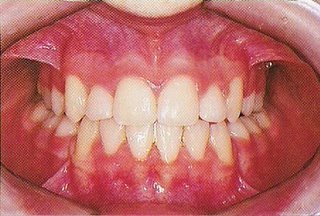
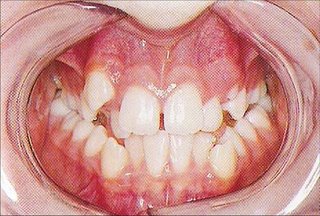 Top: After braces treatment
Top: After braces treatmentBefore braces treatment
Can you be too old for braces?
There is no age limit for braces. As long as you have good periodontal health, braces can be used to straighten your teeth and correct your bite. More people over age 30 are getting braces today than ever before. Most ArchWired readers are between the ages of 30 and 55!
What is a malocclusion?
Occlusion is another word for your bite -- how the teeth in your top and bottom jaw meet with each other. So, a malocclusion means a bad bite -- a bite with problems.
What are the "classes" of malocclusion?
Malocclusion is most often caused by hereditary factors such as an abnormal relationship between the size of the teeth and the size of the jaws. Malocclusion may also result from missing teeth or habits such as thumb sucking or tongue thrusting.
Malocclusions are classified based on the relationship of the maxillary (upper jaw) and mandibular (lower jaw) first permanent molars.
There are three basic classes of malocclusion, Class I, Class II, and Class III:
Class I malocclusion involves crowding, spacing, or overlapping of the teeth. In this classification the upper jaw is in a normal relationship to the lower jaw; that is, neither jaw protrudes.
Class II malocclusion occurs when the bottom jaw is in a more posterior (backward) position than normal. The top teeth appear to protrude out over the lower teeth. One example of this type of malocclusion is often referred to as "buck" teeth.
Class III malocclusion occurs when the lower jaw is in a more anterior (forward) position than normal. The lower teeth protrude out beyond the upper teeth. This is often the most difficult type of malocclusion to correct.
How much do braces cost?
The average cost for a full set of braces in a typical two-year treatment is about $5,000 US. The cost varies depending on where you live. Major metropolitan areas tend to be slightly higher in cost than rural areas. Generally, metal braces cost less than ceramic. Invisalign treatment can be just as costly as traditional braces, and sometimes is even slightly more expensive.
Can I get braces just on the top or bottom?
That depends on your case. Orthodontics isn't just about making your teeth straight or making them look better. Most dentists and orthodontists take a lot of things into consideration when recommending treatment, such as:
1.how the top and bottom teeth meet with each other (i.e., your bite)
2.how well you can chew your food
3.whether you have a tongue thrust problem
4.whether extraction or surgery will be necessary to correct your problems
5.whether you will need any appliances in your treatment, such as a palate expander or headgear (yes, some adults do wear headgear)
So you see, it isn't just a matter of making your teeth look pretty. There are lot of other factors to take into consideration. This is why you sometimes need a full set of braces, even if you think that you only need them on top or bottom. Of course, some people are lucky. Their bites are good and perhaps they only need a bit of straightening. People in this position often can get braces only on top or bottom
When will I begin to see changes in my teeth after the braces are put on?
According to a recent ArchWired poll, most people begin see changes in their teeth in the first 2 to 6 weeks of treatment.
Should I get teeth extracted as part of my orthodontic treatment?
It depends on your specific case. When we are young and our jaws are still growing, dentists/orthodontists can work with our growth to straighten the teeth without extraction.
But once we are adults, dentists are limited to what is already in place. If your orthodontist recommends extraction, it may be wise to get at least one more (if not two more) opinions before going through with the procedure -- once the teeth are gone, they're gone! Sometimes, depending on your unique case, extraction may be the only way to successfully straighten your teeth and correct your bite.
How long does it take to close gaps between teeth after an extraction?
That depends on your unique physiology. Gaps in teeth on the lower jaw tend to close slower than on the upper jaw. It can take anywhere from a few months to a year to close extraction gaps.
Tuesday, January 03, 2006
Types of gum diseases
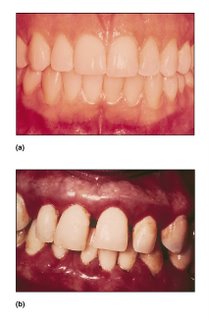
Well...just like other diseases, gum disease also consist of a few types. There are many forms of periodontal disease. The most common ones include the following.
Gingivitis
Gingivitis is the mildest form of periodontal disease. It causes the gums to become red, swollen, and bleed easily. There is usually little or no discomfort at this stage. Gingivitis is reversible with professional treatment and good at home oral care.
Aggressive Periodontitis
A form of periodontitis that occurs in patients who are otherwise clinically healthy. Common features include rapid attachment loss and bone destruction and familial aggregation.
Chronic Periodontitis
A form of periodontal disease resulting in inflammation within the supporting tissues of the teeth, progressive attachment and bone loss and is characterized by pocket formation and/or recession of the gingiva. It is recognized as the most frequently occurring form of periodontitis. It is prevalent in adults, but can occur at any age. Progression of attachment loss usually occurs slowly, but periods of rapid progression can occur.
Periodontitis as a Manifestation of Systemic Diseases
Periodontititis, often with onset at a young age, associated with one of several systemic diseases, such as diabetes.
Necrotizing Periodontal Diseases
An infection characterized by necrosis of gingival tissues, periodontal ligament and alveolar bone. These lesions are most commonly observed in individuals with systemic conditions including, but not limited to, HIV infection, malnutrition and immunosuppression.
Figure on the left shows the differernces between healthy gums (a) and gum with disease (b). So remember..take care your oral hygiene to prevent gum disease!!!
Sunday, January 01, 2006
Proper brushing technique
Proper brushing is essential for cleaning teeth and gums effectively. Use a toothbrush with soft, nylon, round-ended bristles that will not scratch and irritate teeth or damage gums.
1.Place bristles along the gumline at a 45-degree angle. Bristles should contact both the tooth surface and the gumline.
2.Gently brush the outer tooth surfaces of 2-3 teeth using a vibrating back & forth rolling motion. Move brush to the next group of 2-3 teeth and repeat.
3.Maintain a 45-degree angle with bristles contacting the tooth surface and gumline. Gently brush using back, forth, and rolling motion along all of the inner tooth surfaces.
4.Tilt brush vertically behind the front teeth. Make several up & down strokes using the front half of the brush.
5.Place the brush against the biting surface of the teeth & use a gentle back & forth scrubbing motion. Brush the tongue from back to front to remove odor-producing bacteria.
3G craze

Nowadays..people are into these high tech handphone that has multifunction.The latest craze in Malaysia i guess is the 3G phone.I myself admit that fascinated with these handphones.However..most of the 3G enabled phone that are currently in the market are quite huge and heavy for a girl i must say...Thank god..samsung recently just released their 3G enabled phone i.e SGH-Z500.This HP has full 3G functions i.e video telephone,video streaming and video messaging..minus the bulkyness and weigh of other powered 3G phone.The best part about this HP is that it not only just good looking but have all the neccesary fuction.It also light weight at 95g,with dual camera,64 polyphonic and mp3 ringtones,bluetooth techonology and with 50MB memory.It is also affordable as it is sold at RM 1,2999 ( about $350) here in Malaysia.
Another handphone that worth notice is the Sony Ericsson walkman phone.W600i Walkman?is a mobile phone for music lovers. FM radio, an advanced digital music player inside and everything you need to enjoy your music on the move. CD ripping software is included in the kit to get your favorite songs into your phone. Drag and drop using Disc2Phone? Swivel-action W600i has a 1.8?color screen for best possible video viewing and gaming experience and dedicated gaming buttons for fast and action-packed 3D gaming on the go. When you want to catch some action, W600i is also an impressive 1.3 megapixel camera with video recording and digital camera menus.Key feature are.... Walkman?media playerMega Bass?and stereo widening Stereo headset, USB cable and Applications Suite supplied 1.3 megapixel camera Bluetooth,infra red,USB support
Not only that it has 256MB memory but u can upgrade it because this HP uses sony memory stick.This HP is perfect for music lover like me.However..the only drawback is that it is quite bulky and heavy..